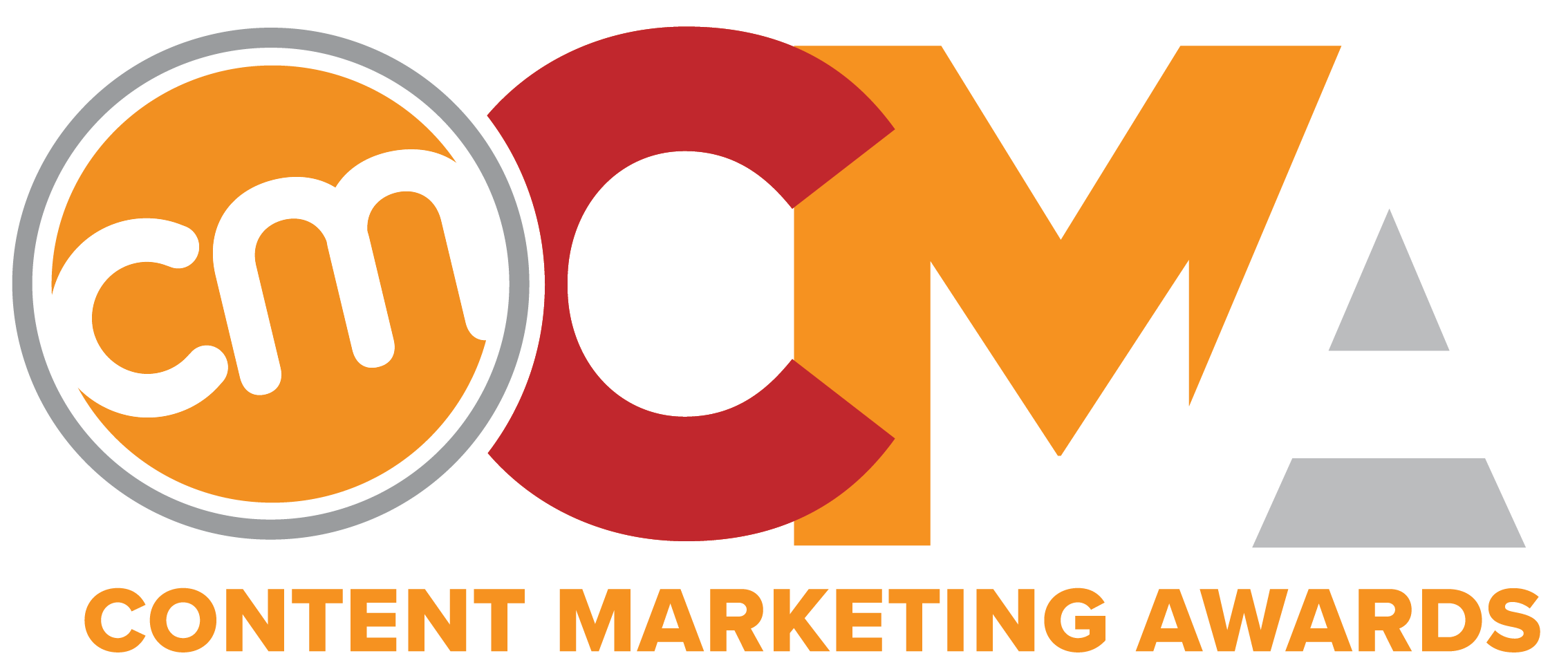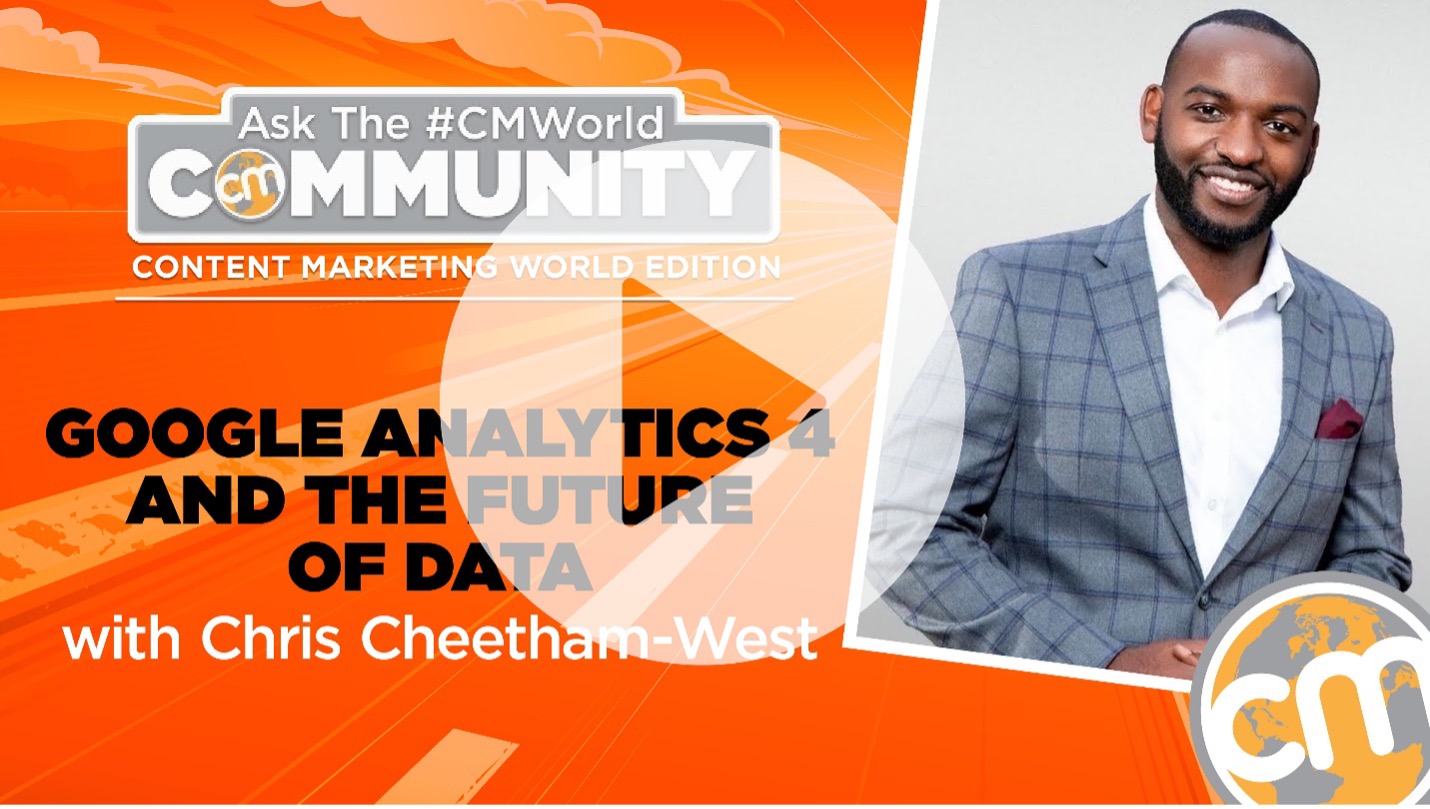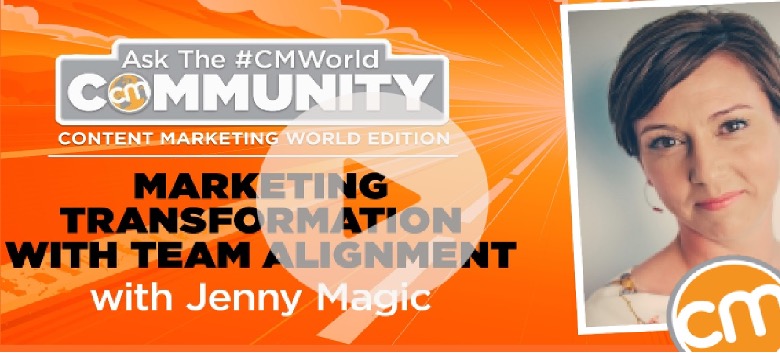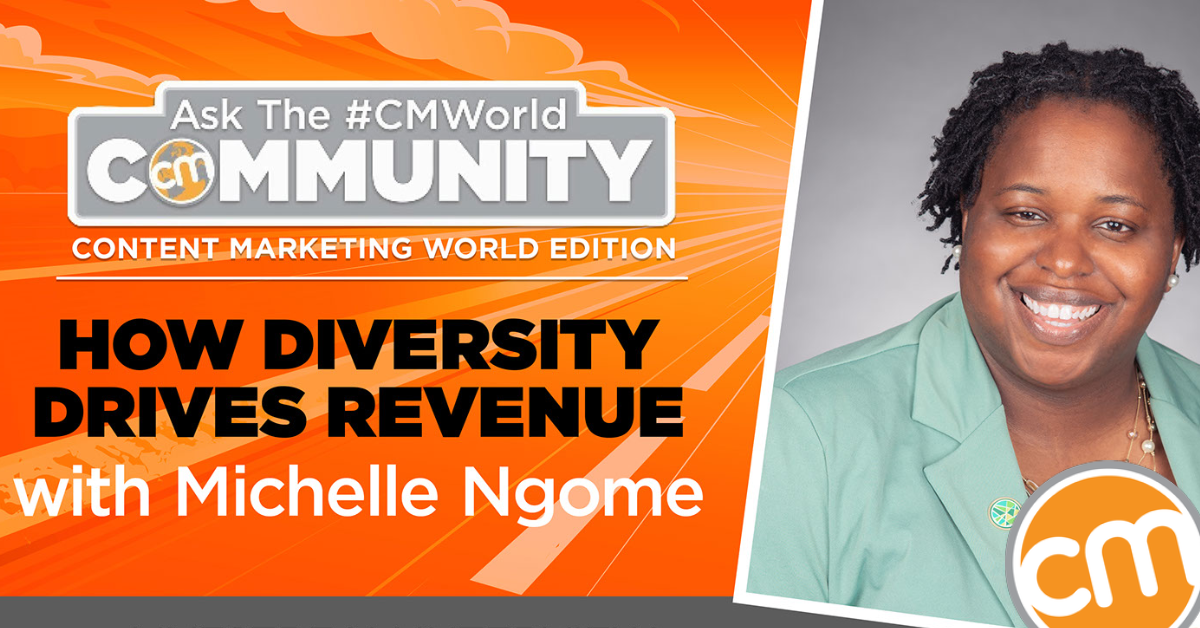Content Marketing World has so much great content and networking (parties!) to offer through the week. But we also want to help keep you healthy and fit while you’re here.
Continue readingGoogle Analytics 4 and the Future of Data | Ask the #CMWorld Community with Chris Cheetham-West
Chris Cheetham-West, Founder & President of LR Training joined the #CMWorld Community livestream, to chat about steps to a successful migration to Google Analytics 4.
Continue readingMarketing Transformation with Team Alignment| Ask the #CMWorld Community with Jenny Magic
The #CMWorld Community livestream, CMI host Amanda Subler interviews CMWorld speaker Jenny Magic, strategy consultant and “marketing therapist” at Better Way To Say It.
Continue readingCreating a Sales Strategy for YouTube | Ask the #CMWorld Community with Tim Schmoyer
Tim Schmoyer, founder of Video Creators, discusses tactical tips and best practices when it comes to using YouTube to convert your viewers into sales.
Continue readingDrive Revenue with Diversity | Ask the #CMWorld Community with Michelle Ngome
The world is evolving. It is important to understand the methods to market to diverse audiences.
Continue readingOptimize Your Content Marketing Program for ROI | Ask the #CMWorld Community with Michael Brenner
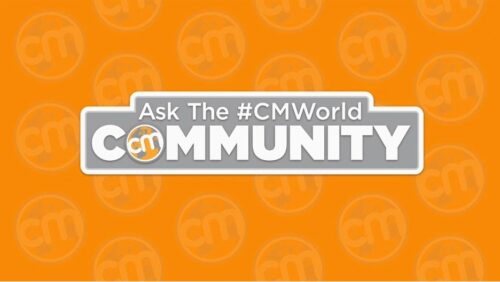
Every business creates content. But few know how to define the right KPIs, plan out the content that answers important customer questions, map that content to the buyer journey, distribute to the right audiences, and get measurable business results.
During this week’s Ask the #CMWorld Community livestream, CMI host Amanda Subler interviews CMWorld speaker Michael Brenner, CEO of Marketing Insider Group, about some of the best ways to optimize your content marketing program for ROI. The conversation is a preview of Michael’s upcoming session at Content Marketing World 2022.
Key Takeaways from the interview:
- Build a business case by reaching, engaging, converting, and retaining buyers you would have never reached if you didn’t do content marketing.
- You need to inform and educate your audience by identifying the questions that they are asking, then answer them.
- Don’t get caught up in the “Quality vs. Quantity” debate. Just create more, better content.
Watch this interview then come hear Michael Brenner speak at Content Marketing World 2022 You’ll soon be able to check out the agenda here.
You can participate in the interactive Ask the #CMWorld Community livestreams most Mondays at Noon ET on LinkedIn, YouTube, Facebook or Twitter. Check out some of the past interviews in this playlist.
Amanda Subler (06:42):
What mistakes are organizations making when it comes to optimizing their content marketing and, and why do they need to change?
Michael Brenner (06:59):
I’ve answered this a few different ways over the years, because it does take different forms. There’s a spectrum, I think of brands that fit along the promotion to emotion, let’s say spectrum. Every brand creates content that has to, you know, explain the products and services they sell. The problem is that sales-driven organizations, product-driven organizations, sometimes overly sell and overly promote. And it’s not about not doing that stuff. It’s just about making sure there’s an appropriate mix of content that educates, that attracts, you know, reaches to new audiences to, introduce them to your brand and to your products. And so, the reason I started the agency that, I run really is, and was to solve that big problem that I saw as a corporate marketer, that I saw as a consultant, it’s really thought leadership, educational, consistent content that earns the right to sell, before you push product and push price and all those kinds of things.
So, another way to say it is, mapping content appropriately to the buyer journey or balanced to the buyer journey. A lot of companies, I think they think the buyer journey starts with, “they reached out to us.” When the buyer journey starts long before that, before people even realize they have a problem. And so, that’s the biggest mistake that I hope to help solve.
Amanda (08:26):
And you kind talk about, the importance of, and I think we know this building a business case, right? It’s very hard, but it’s important. And you know, those executives, they wanna see the ROI. So what are some of the best or the easiest ways to show the importance of our content marketing program?
Michael (08:43):
Yeah, I’m gonna, rely on my, most tweeted tweet, which I know you’ve heard before, but it’s, “behind every bad piece of content is an executive who asked for it.” So, I think it’s, it’s kind of funny. It’s kind of ironic but it’s unfortunately true. I talk to content marketers all the time that are frustrated. And I think the reason they’re frustrated is because they don’t feel accountability or buy in from the top to do the kind of content that they want to do. I mean, I think those of us in content marketing, we know what to do but we’re not allowed, or we’re told to do different stuff, or we’re told to do more of the wrong kind of stuff.
So, building the business case is so important. It’s the reason content marketers are frustrated. It’s the reason a lot of content doesn’t perform or, does the opposite. It actually pushes people away from us. So, I think building the business case is really important, but I also think the way to do it is super simple. And, and so in the content formula, it’s the first chapter. And I always talk about it’s reach, engage, convert, and retain buyers. We would’ve never reached if we didn’t create early stage educational content, if all you do is sell, all you’re gonna do is talk to people who already know who you are, and you’re going to turn a lot of them away because they may not be ready for the sale.
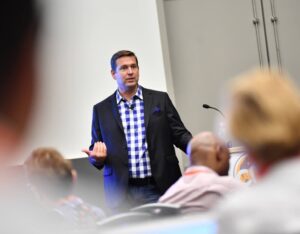
If you educate, if you inform, if you try to lead through thought provoking, insightful, opinionated kind of content, you’re gonna attract more of the right kind of people. You’re gonna engage them with the right kind of content. You’re gonna start to form relationships that hopefully drive conversions and pipeline for sales and direct revenue. And, then really interestingly, the forgotten child of marketing objectives retention, what we’ve found with every company we’ve worked with is that clients and relationships and new sales that are formed and converted from content marketing. They stay longer, they spend more. And so, you’re retaining those clients over a longer period of time and for better return on investment. So, reach, engage, convert, and retain buyers you would have never reached if you didn’t do content marketing.
Amanda (10:47):
You also talk about the importance of answering their questions, which seems easy enough. Right? But a lot of people don’t, like you said, or answer the wrong questions. So, what are some of the best ways to figure out what questions to answer? Any tools to help?
Michael (11:26):
If anyone’s familiar with that term or that line of thinking, at the very first CMWorld, I went to Marcus Sheridan’s keynote session. He wrote a book about that keynote, and it was, “They ask, You answer.” And it’s just such an amazing… as a newbie content marketer, it was so inspirational for me. The great thing about it, and this ties back to the business case, is, in the digital world we live in, the questions your audience is asking is a knowable thing. And so, you mentioned tools. AnswerThePublic, BuzzSumo, Semrush, or just looking at your own internal search on your website.
All of those tools can help you identify the questions that people are asking. I like to think like a journalist. Journalists aren’t experts in the topics they cover, but they go interview experts and they ask them, who, what, when, where, why and how. And so, are you answering the who, what, when, where, why and how questions that your audience is asking? My favorite one when I was at SAP, we were launching a big data solution, software solution. And the content that we were pushing to publish was: What is big data? Who cares about big data? Why does your company need to think about managing or building software to manage the big data inside your organization? Those are really simple, basic questions that product people, they think that the folks they’re selling to are already beyond that. And yet the economic buyer, the CFO, he doesn’t know what big data is or cloud computing or AI and all these other sort of technical solutions that many of us sell.

So, we need to inform, we need to educate. Who, what, when, where, why, and how is a great way to do that. AnswerThePublic will tell you. Just type a keyword into AnswerThePublic. It’s, free for English language. And it’ll tell you all the who, what, when, where, why and how questions that people are asking. It does it in a beautiful mind map way. And I love to say it’s an editorial strategy on a page. We do some Google keyword research using Semrush or Moz, or some other tools like that. But we look for things like buyer intent, related keywords, long tail keywords, competitive gaps. For my own content strategy, I love looking at some other agencies like ours and what do they rank for that we don’t, and what content is resonating with those audiences on their websites. And, you know, we try to create a better version of it. So, it’s a knowable thing. It’s not an easy thing to do, but it’s a straightforward process to identify those questions.
Amanda (13:58):
Quality versus quantity debate. Many say quality’s more important than quantity when it comes to content, but you believe something slightly, a little bit different?
Michael (14:35):
This question has gotten me worked up every time it comes up because it’s kind of, it’s a false choice. And, we don’t have to choose. And the reason it makes me angry is because I think there are people that love to say, “Should we do quality or quantity?” because they know everyone’s gonna say quality first, let’s focus on quality. Let’s not push more crap out. But the fact is it’s easy to say that, and it’s easy for us to believe that, but the facts and the math tell a different story. So, so I’ll come to that in one second. But before I do, I’m not saying that we should create more crap. What I always say, and Robert Rose supports this, and Andy Crestodina supports this. And Jay Acunzo and I have kind of riffed on this in the past before as well.
We need to create more better content or more quality content, not less good stuff, or only really good long stuff. I’m not saying we should create bad things, but again, you ask a journalist. My favorite quote is Mark Twain, who said, that inspiration comes from a deadline. His inspiration was driven by the fact that he had to publish an article every week for his publisher. He didn’t seek out to write crappy stuff. He wanted to hit his deadline and create the best thing he could within the time he had. And that’s what I think we have to do as content marketers. The math of it shows in HubSpot data almost every other year comes out to support this. Brands that publish on a frequent consistent basis, see two to five times more traffic, two to five times more leads than the brands that publish infrequently or less frequently.
And so that’s why as an agency we offer, sort of like a subscription blog series of content offers one or two articles a week, because we know that when you move from infrequent to once or twice a week, you get that one to three X bump in traffic and leads. And, then we measure that for our clients. And so the math is there. You need to create more, better stuff, not, hey, let’s just create less stuff, but make it really, really good and really deep. Unfortunately, the data proves that just doesn’t work.
Amanda (16:48):
Another thing you talk about is the importance of creating an annual content plan or calendar and stick to publishing it, which I also think is one of the hard parts. So why is this so important and maybe, you know, a couple of best practices to help?
Michael (17:13):
I think it is really important because any publisher website would tell you they… I love to say like CNN, doesn’t decide that, oh, there’s nothing going on in the US today, we’re just gonna, we’re only gonna talk about, world politics and not the US, or Fox or whoever you subscribe to. They’re publishing every single day on world politics, US politics, technology, business, whatever categories of content publishers cover, they publish on a frequent, consistent, committed basis. So that’s one perspective. The other perspective is, and Joe Pulizzi really, I think, helped me to understand this is, you wanna kind of like make a date with your audience. Like people, they respect consistency. They, respect knowing, the comfort of knowing, that you’re gonna land in their inbox, or you’re gonna publish a new article. At CMI, you guys publish just about every day.
We try to publish three or four times a week. And our audience knows that, and they subscribe for that because they’re, looking for those daily insights that they may ignore, but they’ll tune into when it’s relevant to them. So I think it’s important both as a brand and for your audience to publish consistently. But, you know, another reason is it’s kind of like, if you wanna get in shape, you don’t decide the day before the marathon, that you’re gonna start training. You pick a six month or one year time out, and you start to train slowly over time. And it’s, it’s the persistence, the consistency that really delivers a result. And so, it works and that’s, I think probably the most important point is if you’re trying to drive ROI, drive a business goal deliver pipeline or revenue or sales, publishing consistently works better than any other approach. And so that’s, I think probably the best reason.
Amanda (18:59):
Great. We have a question here from Rachel, how do you measure content to leads for your clients?
Michael (19:09):
I think if you publish consistently, what you find is back to reach, engage, convert, and retain, is you start to build an audience; an identifiable, attributable, measurable audience of people that, for us, we always recommend subscriptions. So if people subscribe to the Marketing Insider Group newsletter, I can tell you how many of those people have ultimately downloaded a white paper or reached out and wanted a sales call with us. So it starts with building, an identifiable audience, moving people from unknown to known. Once you know who they are, you can start to measure their activities- downloads, lead forms, event registrations, click to talk to a salesperson demos. If you’re a B2B software company, free trials, all those kinds of things you can measure once you understand who that audience is. So that’s really the best way we can reach people. We can, identify who they are if they subscribe, or if they’re simply coming inbound to our website from SEO or organic search or social, we can start to see the pathways to conversion from there. And then we can measure the ROI.
Amanda (20:20):
Laurie wants to look at the data, I believe you were referencing in that last question. So we’ll get that for you. Laurie, she’s content-concerned in Chicago because she works with folks who believe less, really good content is the best practice.
Michael (20:35):
There’s a really funny, quick story. I had a former client who we don’t work with them anymore because, they believed that if you look at the data of consumption, shorter content resonates with more people. And, so they wanted to create less and even shorter stuff. And I was like, well, if you follow that math, you, publish a word or a sentence. The problem is you’re never gonna rank. It’s not gonna add any value. No one’s ever gonna read it. And, you might be able to point to millions of people saying, I looked at a word on a page, but it’s not gonna add any value to the business or to the audience. So yeah, I think you have to be careful with the data, but, you know, again, it does really show consistency. Frequency drives results.
Amanda (21:21):
Mouna wants to know, what do you do when you lack ideas for content, except the repurposing strategy?
Michael (21:31):
I love repurposing. So, it’s actually where I think it’s a great place to start. When I was at SAP, I really, I had money to build a platform, but no money for content. And so, the only thing that we could do was repurpose. We did, white papers. We repurposed into blog posts, executive PowerPoints, we repurposed into blog posts. We did interviews with experts, all that kind of stuff. We found bloggers around the company and, invited them to contribute for us. After that, though, we looked to the industry and looked at, okay, if we’re launching a big data product, we have, we want to launch cloud solutions, what are other people in the industry talking about? What are the needs? What are the keywords that they’re searching for? What are the questions that we have the knowledge to answer?
Again, AnswerThePublic can give you that. BuzzSumo is a great tool. You type a keyword in, and it’ll tell you all the stuff that ranks for those keywords. That’s another great tool we love to use. Look at your competition, look at the publishers in this space. I don’t compete with you at CMI, but I’m inspired by your own blog. And every once in a while, I’m like, you know what? I’ve never written a blog on that topic and I’m gonna try to come up with my own angle on that. So, get inspiration from the publishers in your industry, from the leaders. If competitors are not in your industry, there’s … I never find a problem coming up with new ideas. The easiest way is probably get five executives with lots of opinions in a room and do sticky notes and some design thinking. Just ask them to come up with 50 ideas, put them on a wall and categorize them into themes. And there you’ve got a year’s worth of ideas.
2021 Content Marketing Award Top Finalists Revealed
Content Marketing Institute announced the finalists for the top five awards in the 2021 Content Marketing Awards program.
Continue reading